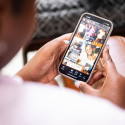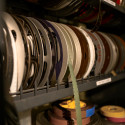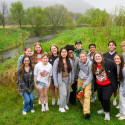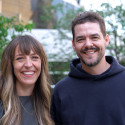Advances
Advances gives a glimpse of the many significant research projects at the university. Tell us about your discoveries. E-mail: wisweek@news.wisc.edu.
A new cheese for UW’s plate
More than 200 years ago, Finns and Swedes started making a flat, squeaky cheese with a buttery flavor. But only recently has this bread cheese, called juustoleipä (pronounced HOO-stah-lee-pah), made it to Wisconsin, when cheesemakers at the Wisconsin Center for Dairy Research developed a safe way to make it.
“This cheese is unusual in that it may be the only cheese in the world to be baked during the cheese-making process,” says UW–Madison cheese expert James Path. “The baking heat caramelizes the sugars on the outside of the cheese to form a tasty crust—similar to brown bread.” The heating method also kills bacteria, enhances the flavor and extends the shelf life.
Path points out that while versions of the cheeese are on the market, many production methods didn’t raise the internal temperature of the cheese high enough.
Interest in making the cheese grew when the Wisconsin Milk Marketing Board funded a specialty cheese project. “The goal was to preserve a traditional, ethnic cheese and develop a safe manufacturing method we could share with small [state] factories and farmsteads,” says Path.
UW joins nuclear engineering consortium
The U.S. Department of Energy recently awarded $10 million to a consortium of four Big Ten schools recognized as leaders in the field of nuclear engineering: UW–Madison, the University of Illinois, Purdue University and Penn State (lead institution).
With the resources provided by this five-year grant, the universities will be able to develop new equipment and techniques, upgrade nuclear reactors and enhance the safe, controlled environments in which the reactors are housed. The resources will improve training facilities and increase access to the equipment. In addition, UW–Madison’s nuclear engineering program in the College of Engineering plans to establish undergraduate scholarships.
“Together, these four universities produce one-third of all graduates in nuclear engineering,” says Michael L. Corradini, chair of Engineering Physics and director of the Wisconsin Institute of Nuclear Systems. “By improving our labs and research programs, we can have an even greater impact on the field.”
Corradini says that one of the goals under the grant is to establish consortium-led minigrants so researchers in other fields can use the reactors for their studies.
Earthwatch Radio turns 30
The highly successful Earthwatch Radio—the nation’s longest-running science and environmental news radio program—marked a 30th anniversary in September.
When it was started by UW–Madison students and staff at the Wisconsin Sea Grant Institute and the Institute for Environmental Studies in 1972, 12 Wisconsin stations subscribed to the service. Today, more than 140 outlets across the United States, Canada and Costa Rica subscribe, and nearly anyone can read transcripts on the program’s Web site: http://ewradio.org.
Earthwatch Radio has received many awards, but Richard Hoops, Sea Grant radio producer and principal investigator for Earthwatch, says the greatest reward is watching the careers of talented students the project has cultivated. “It’s good to know the job meant something to them,” he says. “That’s extremely satisfying.”
Tags: research




